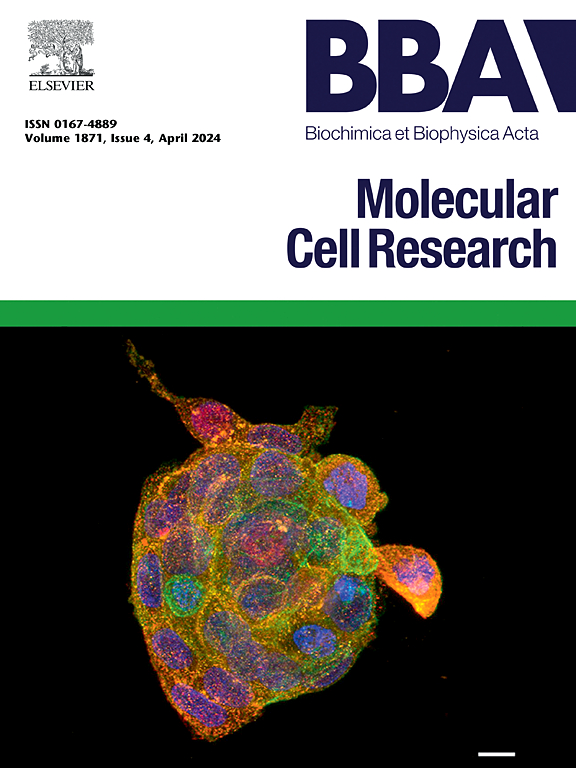脯氨酸异构酶Pin4通过增强磷酸化影响雌激素受体的反活化,从而促进乳腺癌细胞的增殖。
IF 3.7
2区 生物学
Q1 BIOCHEMISTRY & MOLECULAR BIOLOGY
Biochimica et biophysica acta. Molecular cell research
Pub Date : 2025-08-10
DOI:10.1016/j.bbamcr.2025.120044
引用次数: 0
摘要
乳腺癌是女性中最常见的肿瘤,大约70% %的病例被诊断为雌激素受体α (ERα)阳性。雌二醇(E2)-ERα信号无疑参与了乳腺癌的发展,该信号通路的上调与它莫昔芬耐药性有关。然而,ERα调控是复杂的,其潜在机制尚未全面阐明。Pin4是一种促进脯氨酸残基顺反异构化的脯氨酸异构酶。尽管其作用尚不清楚,但对公共数据库的分析显示,Pin4在乳腺癌组织中的表达高于正常组织。在这里,我们发现Pin4调节ERα转录活性,并且对于ERα阳性乳腺癌细胞的增殖至关重要。在MCF7和T47D细胞中,Pin4敲低通过诱导细胞周期阻滞而显著降低细胞增殖。此外,Pin4的沉默会损害e2诱导基因的表达,包括E2F1。我们还发现Pin4与ERα相互作用,并通过促进Ser167的磷酸化影响ERα的转录活性,这参与了类固醇受体共激活因子-3 (SRC-3)向ERα的募集。重要的是,T47D细胞中Pin4基因的沉默减弱了SRC-3与ERα的相互作用。总的来说,研究结果表明,Pin4是er α阳性乳腺癌发展的关键因素,鉴定Pin4抑制剂可能是一种有前景的治疗策略。本文章由计算机程序翻译,如有差异,请以英文原文为准。
Prolyl isomerase Pin4 impacts estrogen receptor transactivation by enhancing phosphorylation and consequently promotes the proliferation of breast cancer cells
Breast cancer is the most common tumor in women, and approximately 70 % of cases are diagnosed to be estrogen receptor α (ERα)-positive. Estradiol (E2)-ERα signaling is undoubtedly involved in the development of breast cancer, and the upregulation of this pathway is linked to tamoxifen resistance. However, ERα regulation is complex, and the underlying mechanisms have not been comprehensively elucidated.
Pin4 is a prolyl isomerase that promotes cis-trans isomerization of proline residues. Although its role remains unclear, an analysis of public databases reveals that Pin4 expression in breast cancer tissues is higher than that in normal tissues.
Here, we reveal that Pin4 regulates ERα transcriptional activity and is essential for the proliferation of ERα-positive breast cancer cells. In MCF7 and T47D cells, Pin4 knockdown drastically decreased cell proliferation by inducing cell cycle arrest. In addition, the silencing of Pin4 impaired the expression of E2-induced genes, including E2F1. We also found that Pin4 interacted with ERα and affected its transcriptional activity by promoting phosphorylation at Ser167, which was involved in the recruitment of steroid receptor coactivator-3 (SRC-3) into ERα. Importantly, the silence of Pin4 gene in T47D cells attenuated the interaction between SRC-3 and ERα.
Collectively, the study findings show that Pin4 is a critical factor in the development of ERα-positive breast cancers and the identification of Pin4 inhibitors could be a promising therapeutic strategy.
求助全文
通过发布文献求助,成功后即可免费获取论文全文。
去求助
来源期刊
CiteScore
10.00
自引率
2.00%
发文量
151
审稿时长
44 days
期刊介绍:
BBA Molecular Cell Research focuses on understanding the mechanisms of cellular processes at the molecular level. These include aspects of cellular signaling, signal transduction, cell cycle, apoptosis, intracellular trafficking, secretory and endocytic pathways, biogenesis of cell organelles, cytoskeletal structures, cellular interactions, cell/tissue differentiation and cellular enzymology. Also included are studies at the interface between Cell Biology and Biophysics which apply for example novel imaging methods for characterizing cellular processes.

 求助内容:
求助内容: 应助结果提醒方式:
应助结果提醒方式:


